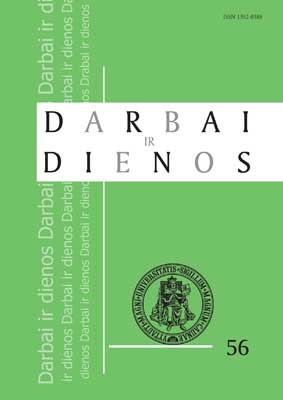Česlovo Milošo gimtojo Šetenių dvaro dokumentai Lietuvos archyvuose
Documents of Czesław Miłosz‘s Native Šeteniai Manor in Lithuanian Archives
Author(s): Raimonda RickevičienėSubject(s): Cultural Essay, Political Essay, Societal Essay
Published by: Vytauto Didžiojo Universitetas
Keywords: Šeteniai; dokumentai; archyvas; documents; Czesław Miłosz; archives
Summary/Abstract: Nobelio literatūros premijos laureatas Česlovas Milošas (Czesław Miłosz1) gimė ir dalį vaikystės praleido Šeteniuose, Kėdainių rajone. Šiuo metu Šetenių dvaro ir jam priklausiusių palivarkų pastatų nelikę, tik rekonstruotas Šetenių dvaro svirnas ir parkas su buvusių tvenkinių pėdsakais. Kadangi plačiau dvaro istorija netyrinėta, šio darbo tikslas – Lietuvos archyvuose surinkti istorinius archyvinius duomenis apie Šetenių dvarą ir jame gyvenusius asmenis, išryškinti juose atsispindinčius ligi šiol nežinotus faktus apie Šetenius ir Č. Milošo giminaičius, o prieduose pateikti svarbiausių dokumentų fotokopijas. This article attempts to reconstruct the history of Czesław Miłosz’s birthplace, the Šeteniai manor, on the basis of documents found in Lithuanian archives. A search of documents archived in the District of Kaunas turned up a sketch of this manor at the end of the 19th century, from which sketch, the earliest known graphic representation of this area, it is possible to form a judgment about the manor‘s buildings and park. The genealogy of Miłosz’s mother’s family had not been previously extensively researched on the basis of birth certificates, which disclosed interesting facts but also left some puzzles: grandfather Zigmantas Kunatas is identified in his marriage entry as born in Skaruliai parish, Skrebinai manor (not Krasnogrūda); his mother J. Kunotienė died in Šeteniai (not Krasnogrūda). Much information on the history of the Šeteniai manor is provided by documents relating to the 1922 Land Reform in Lithuania: these documents throw light not only on questions of land ownership but also on human relations and questions pertaining to wealth and citizenship; they also allow us to recognize the prototypes of some of Miłosz’s heroes.
Journal: Darbai ir dienos
- Issue Year: 2011
- Issue No: 56
- Page Range: 79-115
- Page Count: 37
- Language: Lithuanian

